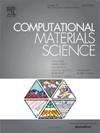Synergistic insights into the tungsten–tantalum-vacancy system: A DFT-cluster expansion study
IF 3.1
3区 材料科学
Q2 MATERIALS SCIENCE, MULTIDISCIPLINARY
引用次数: 0
Abstract
Vacancies play a fundamental role in determining the mechanical properties of alloys of tungsten and tantalum, which are of interest as plasma-facing materials in nuclear-fusion applications. To understand their behaviour, they have been investigated by means of density functional theory, cluster expansion calculations, as well as Monte Carlo simulations. It is found that vacancy formation energies increase with tungsten concentration, and it is easier to remove a tantalum atom than tungsten. Vacancies tend to cluster and form voids with faceted surfaces. A strong tendency towards tantalum segregation around vacancies and voids is observed at all temperatures considered, up to 3000 K. We show how this cloud of tantalum atoms surrounding the vacancies should slow down vacancy migration, thereby influencing their dynamics. This mechanism could in turn delay void formation, which is responsible for mechanical degradation of the alloy upon neutron irradiation. In conclusion, these findings suggest that vacancies induce partial segregation in alloys, which in turn slows down vacancy diffusion, thereby potentially affecting void formation and materials degradation.

求助全文
约1分钟内获得全文
求助全文
来源期刊

Computational Materials Science
工程技术-材料科学:综合
CiteScore
6.50
自引率
6.10%
发文量
665
审稿时长
26 days
期刊介绍:
The goal of Computational Materials Science is to report on results that provide new or unique insights into, or significantly expand our understanding of, the properties of materials or phenomena associated with their design, synthesis, processing, characterization, and utilization. To be relevant to the journal, the results should be applied or applicable to specific material systems that are discussed within the submission.
 求助内容:
求助内容: 应助结果提醒方式:
应助结果提醒方式:


